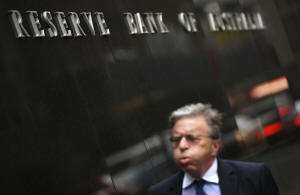Australian central bank cuts benchmark interest rate for the first time
since October 2020
 Send a link to a friend
Send a link to a friend
 [February 18, 2025] By
ROD McGUIRK [February 18, 2025] By
ROD McGUIRK
MELBOURNE, Australia (AP) — Australia’s central bank on Tuesday reduced
its benchmark interest rate for the first time since October 2020 as the
nation’s inflation cools.
The Reserve Bank of Australia reduced the cash rate by a quarter
percentage point from 4.35% to 4.1% at its first board meeting for the
year.
The cut was widely anticipated after inflation rose only 0.2% in the
December quarter and 2.4% for calendar 2024. Annual inflation peaked at
7.8% two years earlier.
The bank manipulates interest rates to keep inflation within a target
band of between 2% and 3%.
“Inflation has fallen substantially since the peak in 2022, as higher
interest rates have been working to bring aggregate demand and supply
closer towards balance,” the board said in a statement.
Bank Governor Michele Bullock later advised against believing economic
forecasts that several more rate cuts were expected this year. The board
will next consider changing interest rates at its meeting on April 1.
“Some other central banks have cut interest rates quite sharply over the
past year, but we have taken a different strategy to most,” Bullock told
reporters.

“Our policy rate was not raised as much as many countries overseas. We
judged that while inflation expectations remained anchored, we could
take a bit longer to bring inflation back to the target band, but we
could keep unemployment lower,” she added.
Unemployment in Australia remained at near-record low levels of 4% in
December, up from 3.9% in November.
Bullock said U.S. plans to increase tariffs on trading partners had the
potential to be bad for economic activity around the world.
[to top of second column] |

A man walks past the Reserve Bank of Australia in Sydney, on Aug. 2,
2016. (AP Photo/Rick Rycroft, File)
 “The tariff threats and what’s going
on overseas is very uncertain and probably even worse, it’s
unpredictable,” Bullock said.
The rate shift is a welcome development for Prime Minister Anthony
Albanese’s center-left Labor Party government which will seek
reelection at elections due by May 17.
Treasurer Jim Chalmers welcomed the independent board's decision.
“This is the rate relief Australians need and deserve,” Chalmers
said in a statement. “It won't solve every problem in our economy or
in household budgets but it will help."
Chalmers said his government had curbed inflation without the
negative consequences experienced in other countries including of
high unemployment, a shrinking economy and recession.
Twelve of the last 13 rate increases have taken place since the
government was elected for its first three-year term on May 21,
2022.
The cycle began in the final days of the previous government’s
tenure when the rate rose from a record low 0.1% to 0.35% on May 4,
2022.
The high cost of living and a shortage of housing around Australia
are expected to be major issues in the upcoming election campaign.
The central bank had held the cash rate at 4.35% since November
2023. That was the highest rate since it fell from 4.5% to 4.25% in
December 2011.
All contents © copyright 2025 Associated Press. All rights reserved |